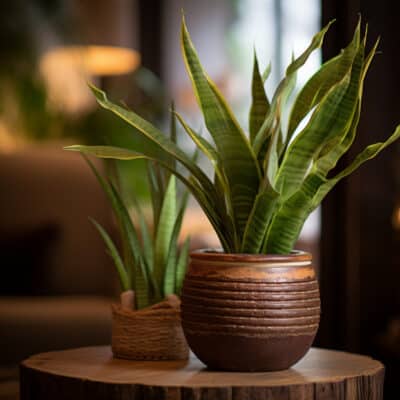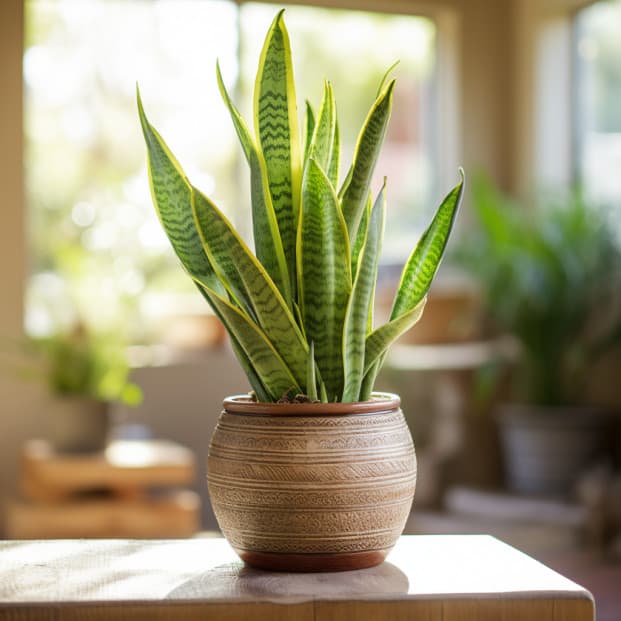
Coco coir is the ideal potting mix ingredient for thriving snake plants.
Unlike standard potting soil, this sustainable planting medium offers some unique benefits for finicky snake plants.
With the right ratio of coco coir in your potting mix, you can help your snake plant thrive like never before.
In this guide, I’ll share my first-hand experience for creating the ideal coco coir potting mix based on the needs of snake plants.
You’ll learn the secrets I’ve uncovered over the years for making your own super-charged potting medium.
With the proper aeration, moisture retention, and nutrition that coco coir provides, your snake plant will reward you with vigorous growth and vibrant leaves.
Let’s dive in and explore how this versatile planting material can transform the way you grow snake plants!
KEY TAKEAWAY
Coco coir for snake plants, what to know?
Coco coir (1) is one of the best soil for snake plants, enhancing their growth, water retention, and overall well-being, making it a must-have for plant enthusiasts.
What Exactly is Coco Coir and Why Use It for Snake Plants?
Coco coir may sound unfamiliar, but it’s quickly becoming a favorite ingredient for potting mixes.
This 100% natural material comes from the fiber of coconut husks.
It offers some great benefits for finicky snake plants that standard potting soil just can’t match.
In my experience, the right amount mixed into your potting mix can help snake plants thrive like never before! It improves moisture control, aerates the soil, and provides nutrients – all things snake plants love.
Here’s an example from my own garden.
I’ve had a tall cylindrical snake plant for over 10 years.
It’s always grown steadily, but last year the leaves started yellowing no matter what I did.
I finally repotted it into a mix with 30% coco coir.
Now its leaves are greener and more upright than ever before!
Coco coir is an ideal snake plant potting mix ingredient.
It creates the well-draining, nourishing, and mineral-rich environment these plants need.
If you want your snake plants to reward you with vigorous growth, it’s time to consider this sustainable growing medium.
Keep reading to learn how to create the perfect blend!
Creating the Perfect Coco Coir to Soil Ratio for Healthy Snake Plants
Finding the ideal coco coir to soil ratio is key for a snake plant potting mix. (2)
Too little coco, and you won’t get the full benefits.
Too much, and the mix may retain too much moisture.
From learning the hard way, I recommend 30-40% coco coir in your custom soil blend.
Here are the ratios that have worked wonders for my snake plants:
- 30% coco coir, 70% cactus/succulent soil mix
- 1 part coco coir, 2 parts potting soil
- 40% coco coir, 40% potting soil, 20% perlite
No matter what basic ingredients you use, that 30-40% coco coir content is the sweet spot.
This gives enough aeration and drainage while still providing moisture retention. It also creates lots of space for new roots to grow into.
I suggest starting with a 30% coco ratio if your snake plant will be in a pot without drainage holes.
Increase to 40% if using a container with ample drainage, as this prevents soggy soil.
Get ready to find your own perfect coco coir snake plant potting mix!
Mixing Coco Coir: Step-by-Step Instructions for DIY Potting Mixes

Creating your own DIY coco coir potting mix lets you customize the perfect soil blend for your snake plants.
With just a few basic ingredients, you can whip up an ideal medium tailored to these picky plants.
Follow these simple steps for foolproof coco coir snake plant soil:
Step 1: Pick your base soil. Go with a commercial cactus/succulent mix or make your own blend of 1 part potting soil, 1 part perlite or pumice, and 1 part compost.
Step 2: Measure out the quantities to achieve your desired coco coir ratio. For 30% coco, use 3 parts base soil to 1 part coco coir.
Step 3: Thoroughly moisten the coco coir brick or bag according to package directions. Coco coir needs to be hydrated before using.
Step 4: Fluff and break up the rehydrated coco fibers with your hands until loose and peat moss-like. Remove any hard lumps or debris.
Step 5: Combine the prepared coco coir and base soil ingredients in a large container. Mix completely with your hands or a trowel.
Step 6: Use the fresh DIY potting mix to repot snake plants or propagate new pups! It’s ready to help your plants thrive.
With these simple steps, you can whip up the perfect snake plant soil in minutes. Custom coco coir blends ensure you control the quality and ingredients. Time to mix your own magic potting medium!
Nutrients and Amendments to Add to Coco Coir for Robust Snake Plants
Coco coir offers great water-holding capacity but is naturally low in nutrients. To create a complete potting mix, it’s key to add fertilizing amendments. Here are great options I recommend:
- Worm castings – Rich in nutrients and microbes. Mix in 1-2 cups per gallon of soil.
- Compost – Boosts organic matter. Aim for 20% of total mix.
- Bone meal – Long-lasting phosphorus source. Sprinkle in 1-2 tbsp per gallon.
- Kelp meal – Provides micronutrients and minerals. Add 1-2 tbsp per gallon.
- Alfalfa meal – Feeds with steady nitrogen release. Mix in 1-4 tbsp per gallon.
- Greensand – Adds potassium and trace elements. Use 1-2 tbsp per gallon.
- Granular organic fertilizer – All-purpose feeding. Follow label rates.
Test different combinations to find your perfect enriching amendments for robust snake plants.
Aim to make the coco coir nutrient-rich and complete.
Your plants will flourish with these additions!
How Coco Coir Potting Mixes Improve Drainage and Prevent Overwatering

Snake plants hate sitting in soggy soil.
This leads to root rot and other problems quick.
Standard potting mixes often become waterlogged, especially in pots without drainage.
That’s where coco coir comes to the rescue!
Coco coir’s natural structure creates ample air pockets when mixed into potting soil.
This aerates the blend and allows for rapid drainage.
The loose, fluffy texture also resists compaction which can smother roots over time.
I’ve found coco coir blends drain at least 2-3 times faster than typical potting mix.
The 30-40% coco ratio provides the perfect moisture balance for snake plants.
Enough is retained for hydration, but any excess drains away.
Here’s an example from my own experience.
I grew a Cape Aloe snake plant that always ended up with wet feet in its old soil.
No matter how little I watered, the leaves yellowed from too much moisture.
Repotting into a coco coir blend completely fixed the problem.
Now I can water freely without stressing about drainage.
The Cape Aloe is thriving with happy roots and no more yellow, soggy leaves!
Coco coir gives snake plants the well-aerated, moisture-controlling medium they need.
Say goodbye to overwatering woes and prepare for faster growth than ever!
Repotting Snake Plants: A Simple Process for Transplanting into Coco Coir
Ready to repot your snake plant into an ideal coco coir potting mix? This process is easy and straight-forward.
Follow these steps for a seamless transition:
Step 1: Choose a container 1-2 inches larger than the current pot with ample drainage holes. Terra cotta or plastic both work well.
Step 2: Water the snake plant thoroughly 1-2 days before repotting. This makes removal from the old pot easier.
Step 3: Remove the plant from its pot and gently loosen any circled roots with your fingers.
Step 4: Partially fill the new container with fresh coco coir potting mix. Place the snake plant in the center.
Step 5: Fill in around the roots and firm the soil lightly. Leave 1 inch between the soil and the rim.
Step 6: Give the newly repotted plant a deep watering to further settle the roots. Then let dry out partially before the next drink!
With an ideal coco coir blend, your snake plant will establish fast and reward you with lush new growth. It’s one of the best things you can do for these plants. Time to get repotting!
Troubleshooting Issues: Tips for Avoiding Pitfalls with Coco Coir Mixes
Coco coir potting mixes offer huge benefits, but a few issues can pop up if you’re not careful:
- Soggy soil – Too much coir or poor drainage causes waterlogging. Fix by increasing base soil ratio.
- Nutrient deficiencies – Coco coir needs added fertilizers. Amend with worm castings, kelp, and compost.
- pH imbalance – Coco can be too acidic for some plants. Add garden lime if leaves yellow.
- Repotting shock – Go gradually when shifting plants to coir. Transition with 25% mix first.
- Moisture fluctuations – Watch soil moisture closely until plants adjust to new medium.
With proper ratios, amendments, and care, you can avoid these pitfalls.
Coco coir offers an amazing growing environment if used thoughtfully! Do your research and start slowly.
Soon your snake plants will be thriving in perfect soil.
Frequently Asked Questions
Do snake plants prefer soil for snake plants or indoor potting soil?
Snake plants can grow in a variety of soil mixes, including regular potting soil, cactus soil, succulent soil, or coco coir based soil.
The most important factors are that the soil drains well and provides adequate drainage.
What is the best soil for snake plants?
Many experienced snake plant growers recommend a soil mix that includes organic potting soil, perlite or coco coir for drainage, and a small amount of organic matter like compost.
This provides nutrients for healthy plant growth while ensuring the soil drains quickly to prevent root rot from excess water.
How do I mix snake plant soil or create a soil recipe for my snake plant?
A simple, effective soil mix for snake plants can be 1 part organic potting soil, 1 part perlite or coco coir, and 1 part compost or worm casting.
This soil mix for snake plants ensures good drainage along with nutrients from the organic matter.
Be sure not to overwater, as snake plants prefer well draining soil.
When repotting my snake plant, what size pot should I use?
When repotting a snake plant, choose a pot that is only slightly larger than the current root ball.
This encourages the roots to continue growing outward within the boundaries of the new pot.
Be gentle not todamage the roots when loosening the soil around the root ball.
Repot in the same well draining soil mix.
Can I use indoor potting soil, cactus soil, or succulent soil for my snake plant?
Yes, indoor potting soil, cactus soil or succulent soil can all work as long as it drains well.
Snakes plants prefer soils that allow for adequate drainage to prevent root rot from excess water retention.
Be sure the soil does not stay soggy.
What soil pH is best for snake plants?
Snake plants are quite adaptable and will grow in a wide range of soil pH levels.
Their preferred soil pH range is between 6.0 to 7.5.
Very acidic soil below 6.0 could inhibit nutrient absorption.
Use a soil with a neutral pH of around 7.0 for best plant growth.
How often should I water my snake plant and does it need special care?
Snake plants are very low maintenance and drought tolerant.
They should be watered just enough to keep the soil slightly moist, about once every 1-2 weeks.
Allow the top inch of soil to dry out between waterings.
Snake plants do not need fertilizer or any special care beyond occasional repotting into well draining soil.
Conclusion
Before you go…
Now that you know how to create the perfect coco coir snake plant potting mix, it’s time to take action!
Head over to my next guide to discover the watering secrets that will keep your snake plant hydrated for maximum growth.
Cracking the Code: How To Water Snake Plants Like a Pro
Snake plants are famously resilient, but improper watering can still hurt them.
Learn professional tips on watering frequency, soil moisture, and signs of under or overwatering.
Get ready to master snake plant care once and for all!
References
- https://en.wikipedia.org/wiki/Coir
- https://planterhoma.com/blogs/planting-tricks-tips/snake-plant-soil
Related Articles
- https://allthingsgardener.com/best-soil-for-snake-plant/
- https://allthingsgardener.com/how-to-splitting-snake-plant/
- https://allthingsgardener.com/why-does-my-snake-plant-smell/


